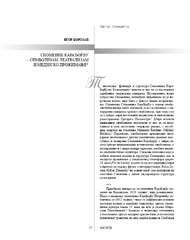Приказ основних података о документу
Spomenik Karađorđu - simbolizam, teatralizam i medijsko prožimanje
The Karageorge monument: Symbolism, theatricalism and media intertwinement
| dc.creator | Borozan, Igor | |
| dc.date.accessioned | 2021-10-12T11:31:15Z | |
| dc.date.available | 2021-10-12T11:31:15Z | |
| dc.date.issued | 2012 | |
| dc.identifier.issn | 1450-605X | |
| dc.identifier.uri | http://reff.f.bg.ac.rs/handle/123456789/1410 | |
| dc.description.abstract | The idea of setting up a monument to Karageorge Petrović, the mythical founder of the modern Serbian state, was stirring Serbian public opinion in the 19th century. Its realization depended on many things. Apart from aesthetic, conceptual and financial considerations, it also depended on political factors. It was the politically limiting presence of Ottoman administration that thwarted the original idea in the mid-19th century. The public function and didactic purpose of a monument to the Serbian national hero was the main obstacle to its erection. Moreover, the reign of the rivaling Obrenović dynasty in the second half of the century also made a sculptural visualization of Karageorge’s image impossible. The new political climate and the accession of King Peter Karageorgević in the aftermath of the May Coup of 1903, however, made the realization of the idea possible. Immediately after the Coup, Karageorge became a widely exploited media figure. In 1903, the National Theatre in Belgrade staged a nocturnal epic of a symbolist author, Dragutin J. Ilić, with Karageorge as its leading character brought to life by acting performance. The concluding scene defined and largely anticipated the monument to Karageorge. The hero of the play, Karageorge, was perched on a commemorative triumphal column surrounded by allegorical and symbolic representations, a sort of design concept for the monument. Eventually, a competition for the monument was launched in 1908, and won by a multimedia artist, Paško Vučetić. From the very outset, the symbolist artist and his project faced harsh criticism from a part of the professional public. The same fate befell the monument after it was unveiled in Kalemegdan in Belgrade, in 1913. The grand dynastic and national spectacle that it occasioned could not appease critics, least of all the most vociferous among them, the painter Moša Pijade. Pijade’s criticism of the monument revealed broader aspects of the moment at which two artistic visions confronted one another. Vučetić, with his symbolist view of the world, stood on one side. His monument’s theatrical flavour was combined with a somewhat fragile image of Karageorge. The universalized hero of the symbolist world, expressed by the symbolist body language, was visualized by Vučetić’s statue surrounded with the nation’s symbolic figures. On the other side was Pijade, whose ideals of heroic modernism called for a strong, muscular, expressive, monolithic colossus. Therefore, Vučetić’s Karageorge was scolded for not being legible enough and not national enough. The entire structure of the monument revealed two opposing views of structure, purpose and form. The contemporary understanding of sculpture, as articulated in Germany in particular, had in the late 19th century became part of the Serbian cultural climate. The difference in understanding sculpture and its purpose suggested that Serbian society and its leading cultural figures were strong enough to absorb foreign influences and to develop them further in a creative way. The monument to Karageorge was short-lived. During the First World War it was pulled down by the Austrian occupying force. The narrative about the monument thus came to its natural end, becoming a topos in a deconstruction of the other, and the locus of a classical obliteration of a community’s collective memory. | en |
| dc.publisher | Zavod za zaštitu spomenika kulture grada Beograda, Beograd | |
| dc.relation | info:eu-repo/grantAgreement/MESTD/Basic Research (BR or ON)/177001/RS// | |
| dc.rights | openAccess | |
| dc.rights.uri | https://creativecommons.org/licenses/by/4.0/ | |
| dc.source | Nasleđe | |
| dc.title | Spomenik Karađorđu - simbolizam, teatralizam i medijsko prožimanje | sr |
| dc.title | The Karageorge monument: Symbolism, theatricalism and media intertwinement | en |
| dc.type | article | |
| dc.rights.license | BY | |
| dc.citation.epage | 47 | |
| dc.citation.issue | 13 | |
| dc.citation.other | (13): 27-47 | |
| dc.citation.rank | M52 | |
| dc.citation.spage | 27 | |
| dc.identifier.fulltext | http://reff.f.bg.ac.rs/bitstream/id/364/1407.pdf | |
| dc.identifier.rcub | https://hdl.handle.net/21.15107/rcub_reff_1410 | |
| dc.type.version | publishedVersion |

